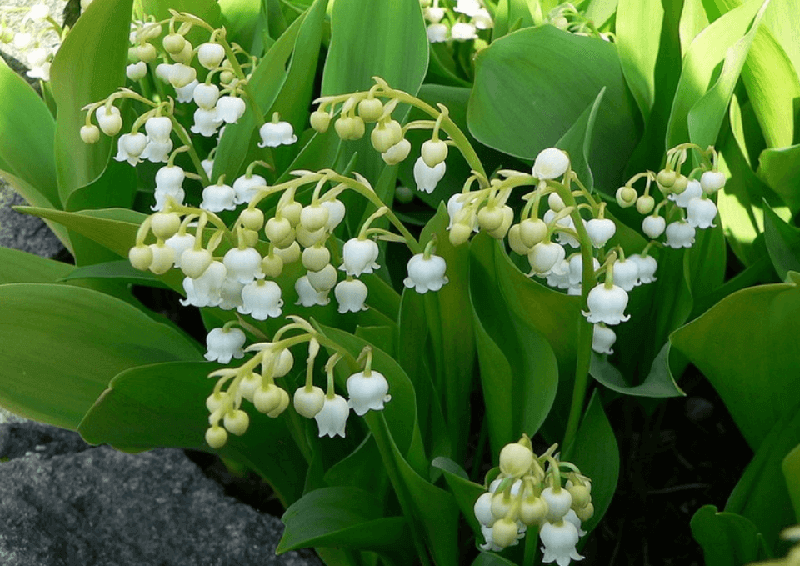Here’s some interesting stuff about the lily of the valley flower! Did you know that it’s also called “May bells” because it blooms in May? The delicate white flowers have a sweet fragrance that is often used in perfumes and cosmetics. However, despite its beauty and pleasant scent, the plant is actually poisonous if ingested, so be sure to keep it away from curious pets and children. In some cultures, lily of the valley is also associated with good luck and is used in wedding bouquets for its symbolic meaning of happiness and humility.

The flower commonly known as Lily of the Valley, or sometimes referred to by other names like May Lily, May Bells, Male Lily, and Our Lady’s tears, is scientifically named Convallaria majalis. This flowering plant belongs to the Ruscaceae family and the genus Convallaria. It is native to regions in North America, Europe, and Asia that have a cool and temperate climate. In Vietnam, it is famous for its captivating fragrance and beauty. The Lily of the Valley is popularly known as “the most fragrant flower in the world.” What are the unique characteristics that give this flower its distinct fragrance?

The lily of the valley is a flowering plant that belongs to the herbaceous perennial family. It has a well-developed root system that spreads underground, creating dense clumps or rhizomes. During springtime when it’s at the growing stage, the rhizome produces many buds. This plant commonly thrives in deep valleys, along cool stream banks, or under the shade of oak trees. It typically grows up to 20-30 cm tall and has only one pair of oblong leaves per plant. The beautiful flower branches bloom with inflorescences of 15-20 white bell-shaped flowers that measure about 5-10mm in diameter. Additionally, these flowers emit a sweet fragrance. Lily of the valley only blooms between early May to mid-June and eventually grows into small red berries that measure around 5-7mm in diameter. Although it’s challenging to dig up this plant, it can easily spread and serve as a quick cover crop. It’s also important to note that the lily of the valley can survive for decades in cool temperate environments but cannot thrive in hot tropical regions. Overall, the lily of the valley is a stunning plant that’s highly regarded for its beauty and sweet fragrance.

The lily of the valley holds great significance in various cultures. In 1982, it was declared the national flower of Finland, and it is also the symbolic flower of Yugoslavia. France celebrates this flower on May 1 every year. This white orchid represents the purity and innocence of love between couples, making it a popular choice for weddings. Royal brides like Queen Victoria, Kate Middleton, Princess Astrid of Sweden, and Grace Kelly have all used it as their wedding flower. The scientific name for this flower is Convallaria majalis, which means “belonging to the month of May”. It is also considered the representative flower of May, for those born in that month. Not only does this flower symbolize love and purity, but it also represents return and reunion. In some Western countries, it is a symbol of God’s resurrection, and people believe that these beautiful flowers were created by the tears of the Virgin Mary. However, it is important to note that the lily of the valley is poisonous and can cause blurred vision, stomach pain, nausea, and decreased heart rate if ingested. Therefore, caution should be exercised when there are children and pets around. Despite its toxicity, lily of the valley has medicinal properties. After drying, the roots and flowers can be made into medicine to treat strokes, heart arrhythmias, edema, urinary tract infections, eye infections, and epilepsy. It is also a popular ingredient in perfumes and cosmetics due to its long-lasting fragrance. Planting and caring for this flower is relatively easy compared to its significant meanings.

Lily of the valley is a low-maintenance plant that can be effortlessly transplanted and cared for. This flower flourishes best in shady areas and thrives in loamy soil that is highly porous and well-draining. The ideal time to plant these flowers is in late Fall, early Winter or early Spring as the climate is coolest during these months. As these plants require a lot of moisture, it is crucial to water them regularly while keeping the soil moist. It would be best to water them during the early morning or late afternoon when the temperature is cooler. Although lily of the valley is admired by many for its captivating beauty and sweet scent, it is important to note that it can also be toxic if ingested, making it imperative for growers to exercise caution.
